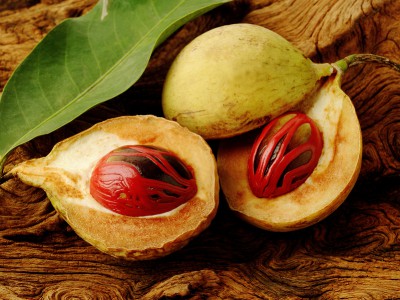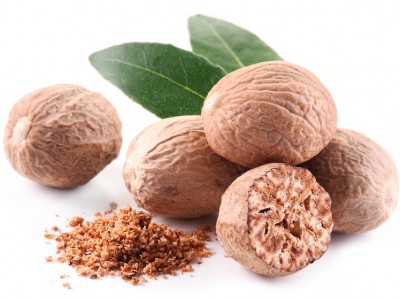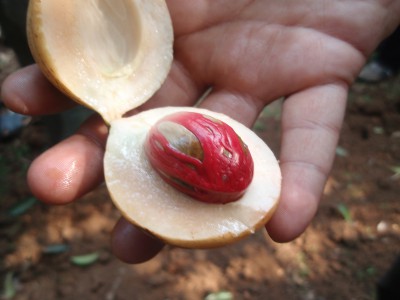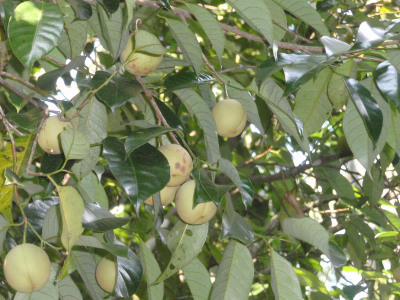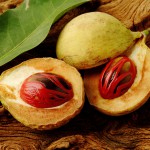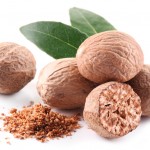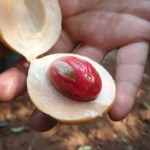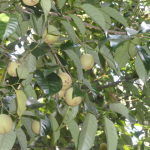Product: Nutmeg Oil
Nutmeg Oil Indonesia Myristica fragrans
-
Description
The nutmeg tree, Myristica fragrans is indigenous to the Moluccas, Indonesia. The fruit contains a nut, which is covered by a hard shell. A red coloured webbing (known as mace) covers the shell. Once ripe the fruit will open revealing the mace and will fall to the ground to be collected or it can be picked just before falling. The mace will be carefully removed leaving the nutmeg (nut) available to be ground and processed.

The oil is extracted from the 'nut' by steam distillation after the grinding of the nutmeg.
The nutmeg is slightly sweeter than mace making the dry or ground spice a favourite in many culinary dishes. As an essential oil it is extensively used in perfumery and pharmaceuticals as well as a natural flavouring for baked goods, beverages, syrups and sweets.
Indonesia exports around 350-400MT of nutmeg oil each year which accounts for around 80% of the global production. Today the product is predominately plantation harvested.
Read more about the impact of recent plantations in our latest Elementary Report.
Read our latest report on Indonesia presented in October 2015 at the IFEAT conference in Sri Lanka, titled 'Indonesia - Current & Future Market Dynamics'

-
Product Details
- Botanical name: Myristica fragrans
- Origin: Indonesia
- Crop Season: All Year
- Plant/part used: Whole Fruit
- Method of extraction: Distillation
- TSCA CAS: 8008-45-5
- EINECS CAS: 84082-68-8
- EINECS: 282-013-3
- INCI Name: Myristica fragrans (Nutmeg) kernel Oil
- Appearance: Colorless to yellow mobile liquid
- Organoleptic Properties: Spicy woody nutmeg powdery terpene.
- Density: 0.883 - 0.923
- Refractive index: 1.474 - 1.488
- Optical rotation: +8º to +30º
- Chemical constituents: Pinene, Sabinene, Limonene, Eugenol, Geraniol, Terpenene, Terpineol, Myristicin, Safrol.
- Fragrance usage:: max. 2%
- Flavor usage:: max. 640 ppm
- REACH: Registered
-
Latest Market Information April 15, 2025
Myristica fragrans, commonly known as nutmeg thrives in tropical climates with high humidity and consistent rainfall. It prefers well-drained and fertile soil. Partial shade is beneficial for the growth of the tree, especially when it is young. Consistent rainfall throughout the year is ideal for its growth.
Nutmeg oil is obtained through steam distillation of the dried nutmeg kernels. Nutmeg is widely used as a spice in culinary applications, while the oil is used by the flavour and fragrance industries. It is also used in pharmaceutical and aromatherapy applications. Nutmeg is also a popular ingredient in traditional medicines.
The nutmeg industry faces challenges, including concerns about quality due to unseasonal weather patterns affecting nutmeg cultivation.Despite these challenges, Indonesia’s commitment to maintaining high-quality standards and meeting international certifications ensures its continued dominance in the global nutmeg oil market. The versatility and widespread application of nutmeg oil across various industries underscore its significance as a valuable export commodity for the nation.
Market prices : USD 72.00 /kilo -
Product Enquiry
To ask us a fair quote for this product, please fill the following form:
-
Documents & Links
List of product Files
 Ultra International B.V.
Ultra International B.V.
